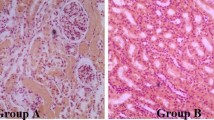Summary
The effects of two glutathione-oxidizing agents, t-butyl hydroperoxide and diamide, on biliary excretion of bilirubin and glutathione disulfide were investigated in anesthetized male Sprague-Dawley rats. Bilirubin (unconjugated) was infused at a constant rate of 100 nmol/kg/min through the jugular vein. When biliary excretion of bilirubin was stabilized, either of the glutathione-oxidizing agents was administered via the mesenteric vein. Biliary excretion of glutathione disulfide increased temporarily after the administration and returned to its basal levels within 20 min. The biliary excretion of bilirubin decreased during the same period and returned to the former levels thereafter. Changes in bile flow rates remained within 20% of the basal levels. A linear correlation was found between the increments in the bile concentration of glutathione disulfide and the decrements in that of bilirubin. Furthermore, separate experiments revealed that reduction of hepatocellular glutathione per se had little effect on biliary excretion of bilirubin. The results thus indicate that the reduction of biliary excretion of bilirubin by glutathione-oxidizing agents was due to the increase in biliary excretion of glutathione disulfide, and suggest that a common biliary excretory mechanism is shared, at least partially, by bilirubin and glutathione disulfide in Sprague-Dawley rats.
Similar content being viewed by others
References
Meier PJ, St. Meier-Abt A, Boyer JL. Properties of the canalicular bile acid transport system in rat liver. Biochem J 1987;242:465–469.
Sippel CJ, Ananthanarayanan M, Suchy FJ. Isolation and characterization of the canalicular membrane bile acid transport protein of rat liver. Am J Physiol 1990;258:G728-G737.
Wolkoff AW, Chung CT. Identification, purification, and partial characterization of an organic anion binding protein from rat liver cell plasma membrane. J Clin Invest 1980;65:1152–1161.
Tiribelli C, Lunazzi G, Luciani M, et al. Isolation of sulfobromophthalein-binding protein from hepatocyte plasma membrane. Biochim Biophys Acta 1978;532:105–112.
Reichen J, Berk PD. Isolation of organic anion binding protein from rat liver plasma membrane fractions by affinity chromatography. Biochem Biophys Res Commun 1979;91:484–489.
Scharschmidt BF. Biliary secretion of bile pigments. In: Ostrow JD, ed. Bile Pigments and Jaundice. New York: Dekker, 1986;243–253.
Lauterburg BH, Smith CV, Hughes H, et al. Biliary excretion of glutathione and glutathione disulfide in the rat; regulation and response to oxidative stress. J Clin Invest 1984;73:124–133.
Akerboom T, Bilzer M, Sies H. Relation between glutathione redox changes and biliary excretion of taurocholate in perfused rat liver. J Biol Chem 1984;259:5838–5843.
Akerboom T, Inoue M, Sies H, et al. Biliary transport of glutathione disulfide studied with isolated rat-liver canalicular-membrane vesicles. Eur J Biochem 1984;141:211–215.
Akerboom T, Inoue M, Sies H, et al. Biliary transport of glutathione disulfide studied with isolated rat-liver canalicular membrane vesicles. Eur J Biochem 1984;141:211–215.
Inoue M, Akerboom T, Sies H, et al. Biliary transport of glutathione S-conjugate by rat liver canalicular membrane vesicles. J Biol Chem 1984;259:4998–5002.
Jansen PLM, Peters HM, Lamers WH. Hereditary chronic conjugated hyperbilirubinemia in mutant rats caused by defective hepatic anion transport. Hepatology 1985;5:573–579.
Jansen PLM, Groothuis GMM, Peters WHM, et al. Selective hepatobiliary transport defect for organic anions and neutral steroids in mutant rats with hereditary-conjugated hyperbilirubinemia. Hepatology 1987;7:71–76.
Oude Elferink R, Ottenhoff R, Liefting W, et al. Hepatobiliary transport of glutathione and glutathione conjugate in rats with hereditary hyperbilirubinemia. J Clin Invest 1989;84:476–483.
Takikawa H, Sano N, Narita T, et al. Biliary excretion of bile acid conjugates in a hyperbilirubinemic mutant Sprague-Dawley rat. Hepatology 1991;14:352–360.
Kurisu H, Kamisaka K, Koyo T, et al. Organic anion transport study in mutant rats with autosomal recessive conjugated hyperbilirubinemia. Life Sci 1991;49:1003–1011.
Oude Elferink R, Ottenhoff R, Liefting WGM, et al. ATP-dependent efflux of GSSG and GS-conjugate from isolated rat hepatocytes. Am J Physiol 1990;258:G699-G706.
Kitamura T, Jansen P, Hardenbrook C, et al. Defective ATP-dependent bile canalicular transport of organic anions in mutant (TR-)rats with conjugated hyperbilirubinemia. Proc Natl Acad Sci USA 1990;87:3557–3561.
Adachi Y, Kobayashi H, Kurumi Y, et al. Bilirubin diglucuronide transport by rat liver canalicular membrane vesicles: stimulation by bicarbonate ion. Hepatology 1991;14:1251–1258.
Clarenburg R, Kao CC. Shared and separate pathways for biliary excretion of bilirubin and BSP in rats. Am J Physiol 1973;225:192–200.
Gregue Z. Stein AF, Klaassen CD. Effect of inhibition of γ-glutamyltranspeptidase on biliary and urinary excretion of glutathionederived thiols and methylercury. J Pharm Exp Ther 1987;242:27–32.
Fernandez-Checa JC, Ookhtens M, Kaplowitz N. Effect of chronic ethanol feeding on rat hepatocytic glutathione. J Clin Invest 1989;83:1247–1253.
Sies H, Summer KH. Hydroperoxide-metabolizing systems in rat liver. Eur J Biochem 1975;57:503–512.
Kosower EM, Correa W, Kinon BJ. Glutathione VII. Differentiation among substrates by the thiol-oxidizing agent, Diamide. Biochim Biophys Acta 1972;264:39–44.
Griffith OW. Depletion of glutathione by inhibition of biosynthesis. Meth Enzymol 1981;77:59–63.
Boyland E, Chasseaud LF. The effect of some carboxyl compounds on rat liver glutathione levels. Biochem Pharmacol 1970; 19:1526–1528.
Tietze F. Enzymic method for quantitative determination of nanogram amounts of total and oxidized glutathione; applications to mammalian blood and other tissues. Anal Biochem 1969;27: 502–522.
Griffith OW. Determination of glutathione and glutathione disulfide using glutathione reductase and 2-vinylpyridine. Anal Biochem 1980;106:207–212.
Eberle D, Clarke R, Kaplowitz N. Rapid oxidation in vitro of endogenous and exogenous glutathione in bile of rats. J Biol Chem 1981;256:2115–2117.
Kosaka A. Total Bilirubin. In: Bergmeyer HU, ed. Methods of Enzymatic Analysis (3rd Ed) Vol 8. Weinheim: VCH Verlags, 1985;591–598.
Yoshida H, Kuronuma Y, Iijima M, et al.The relationship between biliary secretion of bilirubin and glutathione in the rat. Gastroenterol Jpn 1992;27:369–373.
Zimniak P, Ziller S, Panfil I, et al. Identification of anion-transport ATPase that catalyzes glutathione conjugate-dependent ATP hydrolysis in canalicular plasma membranes from normal rats and rats with conjugated hyperbilirubinemia (GY mutant). Arch Biochem Biophys 1992;292:534–538.
Author information
Authors and Affiliations
Rights and permissions
About this article
Cite this article
Kuronuma, Y., Yoshida, H., Iijima, M. et al. Relationship between biliary excretion of bilirubin and glutathione disulfide. Gastroenterol Jpn 28, 292–297 (1993). https://doi.org/10.1007/BF02779233
Received:
Accepted:
Issue Date:
DOI: https://doi.org/10.1007/BF02779233




